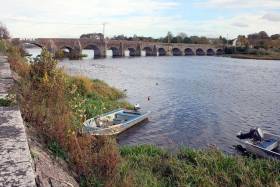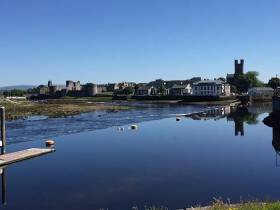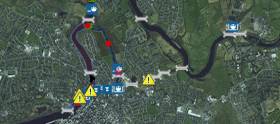Displaying items by tag: Parteen weir
River Shannon Walkway Closed Over Culvert Faults At O’Briensbridge
Waterways Ireland has closed the public footpath running south from O’Briensbridge playground alongside the River Shannon south of Parteen Weir for the foreseeable future, following the discovery of critical failures in two culverts under the path.
Preliminary investigations revealed the need for urgent replacement work on both culverts, the cross-border body for Ireland’s inland waterways says.
It adds that due to the sensitive habitat at the site on the Clare/Limerick border, planning permission is required before the works can go ahead, and this could take up to six months to come through.
“The health and safety risks associated with the two structures are such that it is essential the route is closed and remain so, until after the refurbishment works are completed,” it says.
“Waterways Ireland is aware that this is a popular route for the local community and apologises for any inconvenience caused by this closure.”
Waterways Ireland has advised all users of the Shannon Navigation that remedial work to effect repairs to the infrastructure between Limerick City to Parteen Weir has been delayed and the navigation will not open this week as anticipated.
As Afloat.ie reported in May, the stretch of navigation was closed due to continuing high flow rates and infrastructural deficiencies as a result of the winter storms and subsequent flooding.
Limerick's newly appointed Minister of State Patrick O'Donovan has been asked to intervene with Waterways Ireland to reopen navigation of the River Shannon at Limerick city and avoid the loss of marine tourism revenue to the city writes Andrew Carey.
As Afloat.ie reported earlier, on April 25, Waterways Ireland issued a marine notice advising all users that the river from Limerick city to Parteen Weir would close to navigation.
It cited the "continuing high flow rates and infrastructural deficiencies as a result of the winter storms and subsequent flooding" as reasons for the closure.
Waterways Ireland said that the "floating breakwater at the entrance to the Abbey River in Limerick is no longer in place to protect vessels from striking the fixed weir. Also, there are many strong currents and eddies making navigation dangerous for both large and small craft.
A safety inspection of other damaged floating pontoons further upstream was to be carried out "when water levels and flows permit. Meanwhile, users are advised to stay clear of these until a further Marine Notice is issued on this matter."
Remedial works have yet to take place and the waterway remains closed to all marine traffic during the peak summer season.
Sailors from local sailing clubs wishing to access the Shannon now face the prospect of missing completions and events around the west coast and beyond as they can not pass through the navigation.
Last year, a six point plan to boost marine tourism on the Shannon and in Limerick was launched by then Education Minister Jan O'Sullivan.
The plans, drafted by Limerick marine enthusiasts to benefit local tourism, heritage and education, were submitted to Waterways Ireland.
Well-known boatman Pat Lysaght said that "Limerick is effectively landlocked and until these issues are rectified we will continue to lose out".
Calling for immediate intervention by Minister O'Donovan, who has responsibility for tourism and sport, Cllr Emmett O'Brien said the closure of the waterway "means no boats can sail from Limerick city to Killaloe. This may have a serious impact on local tourism and is contrary to all lip service being paid to Limerick being a riverside city.
"We need a clear and accurate response from Waterways Ireland and the Council why this has occurred and our local Minister for State for Tourism must intervene to ensure this navigation route does not remain closed."
Fianna Fáil Deputy Niall Collins said that it was of huge concern that "Limerick City is effectively closed off to marine tourism and this is having a detrimental impact on tourism across the Shannon region.
“I’m calling on Waterways Ireland to outline when the navigational hazards it has identified along the river will be addressed. We need to know the planned schedule of works and when the river will be reopened to marine traffic.
"We can’t have a situation whereby boats cannot sail up or down the River Shannon during the peak of the tourist season. This needs to be addressed without delay."
At the time of going to press, Limerick City Council and Minister O'Donovan had failed to respond to queries.
Waterways Ireland issued this statement on Wednesday afternoon.
"The stretch of navigation from Limerick city to Parteen Weir remains closed to navigation due to continuing infrastructural deficiencies as a result of the winter storms and subsequent flooding.
"Waterways Ireland, following the 2015/2016 flooding event has and continues to restore the infrastructure right along the Shannon navigation following on from the damage caused by record flood levels and the prolonged duration of these floods during last winter.
"However, Waterways Ireland has limited resources available to it and has had to prioritise its' interventions in those areas of greatest need and use."
The statement did not indicate any timeframe for reopening of the navigation.
Waterways Ireland advises all users of the Shannon Navigation that the stretch of navigation from Limerick City to Parteen Weir is closed to navigation due to continuing high flow rates and infrastructural deficiencies as a result of the winter storms and subsequent flooding.
Users should note that the floating weir at the entrance to the Abbey River in Limerick is no longer in place to protect vessels from striking the fixed weir. Also, there are many strong currents and eddies making navigation dangerous for both large and small craft.
Floating pontoons have been damaged and are not suitable for mooring to or walking on, safety inspection of these will be carried out when water levels and flows permit. Meanwhile, users are advised to stay clear of these until a further Marine Notice is issued on this matter.































































